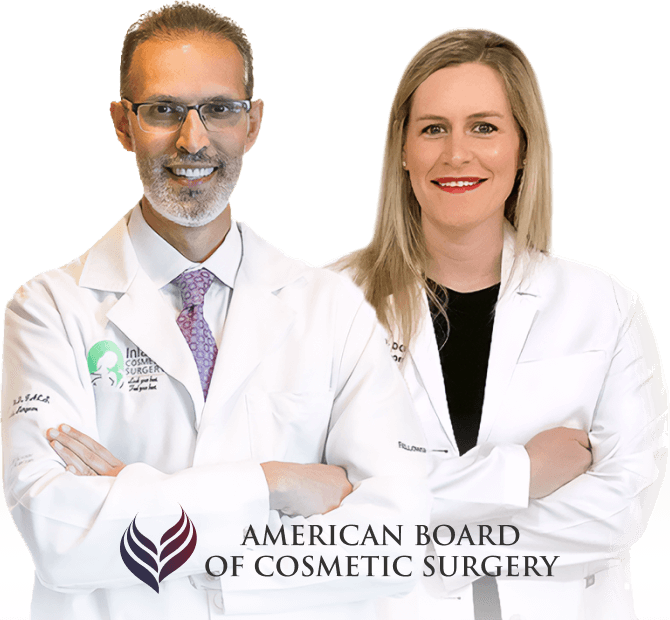We understand that choosing to enhance your curves is a deeply personal decision, and for some patients, fat transfer to the breast offers a natural alternative to traditional breast augmentation with implants. Our Rancho Cucamonga cosmetic surgeons perform a range of breast surgeries and can help you determine which procedure will achieve your body goals.
What is fat transfer breast augmentation?
Fat transfer breast augmentation, also known as fat grafting or autologous fat transfer, is a procedure where we use liposuction to harvest fat from areas of your body where it is unwanted, purify it, and then inject it into your breasts to increase their volume and improve their shape.
Some patients choose fat transfer breast augmentation if they desire a modest increase in breast size, prefer more natural enhancement, and wish to contour another area of the body with targeted fat reduction at the same time.
Benefits of fat transfer breast augmentation
Fat transfer breast augmentation offers numerous benefits:
- An ultra-natural look and feel: Because fat transfer breast augmentation uses your own fat, the results are soft, natural, and blend seamlessly with your existing breast tissue.
- Multiple areas of enhancement: We’ll sculpt the “donor” site with liposuction so you’ll enjoy slimmer, more defined body areas and a natural boost in breast appearance.
- Fewer risks: With no implants involved, there is no risk of rupture or capsular contracture, which are rare concerns with traditional breast implants.
- Minimal scarring: We use very short incisions and small cannulas for liposuction and fat injection, which results in minimal scarring.
Ideal candidates for fat transfer breast augmentation
Most patients are good candidates for fat transfer breast augmentation. This procedure is well-suited for those in good overall health who have realistic expectations and possess enough donor fat in areas like the abdomen or waist to achieve the desired breast volume.
During your consultation, we will assess your candidacy and discuss your goals to ensure this procedure is right for you.
For patients who don’t have enough fat for traditional fat grafting, AlloClae fat injections provide an alternative option using donor-derived fat tissue, eliminating the need for liposuction while still achieving natural breast enhancement.
The fat transfer procedure
The fat transfer breast augmentation process involves several key steps:
1. Liposuction: First, we perform liposuction to carefully harvest fat from donor areas such as the abdomen, thighs, or flanks. This step provides the necessary fat for the transfer but also helps contour areas that can be hard to target with diet and exercise.
2. Purification: The harvested fat is then purified using a specialized process to ensure only the highest quality fat cells are used for transfer.
3. Injection: The purified fat is meticulously injected into your breasts in small, precise amounts to add shape and projection for a natural and even enhancement.
The entire procedure typically takes a few hours, and you can expect to go home the same day. We will provide detailed pre-and post-operative instructions to ensure a smooth experience.
Recovery and aftercare
Recovery from fat transfer breast augmentation is typically quite short. Swelling and bruising are common in both the donor and recipient areas. These will gradually subside over the first few weeks. Light activities can typically be resumed within a week, with a gradual return to more strenuous activities over several weeks—we will lift activity restrictions based on your healing progress.
Risks and considerations
There are risks associated with any surgical procedure, and while fat transfer breast augmentation is considered safe, potential risks and complications may include:
- Some of the transferred fat may be reabsorbed by the body, which could affect the final volume. While we account for this fact in your surgical plan, multiple sessions may be required to achieve the desired results.
- There may be slight differences in breast size or shape post-procedure.
- Although rare, infections or cysts can occur. Choosing an experienced surgeon significantly reduces these risks.
- Key Benefits
- Glossary
- Provides a subtle, natural enhancement
- Reduces fat and contours other body areas
- Avoids potential side effects associated with breast implants
Fat Cells: Cells in the body that store fat, used in fat transfer procedures to add volume to the breasts.
Breast Implants: Silicone or saline-filled devices inserted into the breasts to increase their size.
Breast Size: The measurement of the breasts, often increased through augmentation procedures.
Breast Lift: Breast lifts are surgical procedures to raise and firm the breasts by removing excess skin and tightening surrounding tissue.
Fat Grafting: A technique where fat is taken from one part of the body and injected into another, such as the breasts, for added volume.
Natural Breast Augmentation: Enhancing breast size using the body’s own fat instead of synthetic implants.
Fat Transfer Surgery: A procedure where fat is taken from one area of the body and transferred to the breasts to increase volume.
Traditional Implants: Breast implants made of silicone or saline used to enhance breast size.
Breast Tissue: The tissue that makes up the breasts, including fat, glands, and connective tissue.
Initial Consultation: The first meeting with a surgeon to discuss goals, options, and the surgical plan.
Recovery Process: The period after surgery where the body heals and adjusts to the changes made during the procedure.
Traditional Breast Augmentation: Enhancing breast size using silicone or saline implants.
Cup Size: A measurement of breast size used in bra fitting, often increased through augmentation.
Cosmetic Procedure: A medical procedure focused on improving appearance rather than addressing health issues.
Autologous Fat Transfer: Using a patient’s own fat cells to enhance the size and shape of their breasts.
Breast Reduction: A surgical procedure to decrease breast size by removing excess fat, tissue, and skin.
Boob Job: A colloquial term for breast augmentation surgery.
Breast Enlargement: The process of increasing breast size through surgical means.
Juvéderm: A brand of dermal filler used to add volume and smooth out wrinkles.
Restylane: Another brand of dermal filler similar to Juvéderm, used to add volume to the face.
Results
You’ll see initial results immediately, with final results becoming apparent as swelling subsides and the fat settles, usually within three to six months. Although some fat is expected to be reabsorbed (we add enough volume to account for this occurrence) most of the transferred fat will remain.
Weight fluctuations may impact your results so maintaining your weight after your natural breast augmentation will help you enjoy the results for years to come.
Fat transfer vs. breast implants
When deciding between fat transfer and breast implants, consider the following
- Fat transfer uses your own fat for a subtle enhancement, while implants offer more significant volume changes.
- Fat transfer has a quicker recovery and fewer risks of complications, but implants may provide more predictable and dramatic results, as well as more enhanced upper pole fullness.
- Fat transfer relies on patients having a sufficient amount of quality donor fat, however, implants can be placed on nearly any body type.
If you are very thin or desire a larger increase in bust size, we may recommend breast implants that will meet your expectations. Advancements in implant technology have given patients an impressive range of implant sizes, shapes, and profiles to suit almost any preference and lifestyle.
AlloClae: A non-surgical alternative to fat grafting
For patients who love the idea of fat transfer breast augmentation but don’t have sufficient donor fat for harvesting, AlloClae fat injections are an innovative solution. This FDA-cleared treatment uses donor-derived adipose tissue to add natural-looking breast volume without requiring liposuction.
AlloClae is ideal for:
- Slim patients without adequate fat reserves for traditional fat grafting
- Patients who prefer to avoid liposuction
- Those seeking a less invasive alternative with minimal downtime (1-2 days recovery)
- Modest breast enhancement without implants
The procedure is performed in-office with local anesthesia and typically takes less than an hour. Results last 12-18+ months, significantly longer than traditional dermal fillers.
Fat Transfer Breast Augmentation FAQs
References »
Davis MJ, Perdanasari AT, Abu-Ghname A, Gonzalez SR, Chamata E, Rammos CK, Winocour SJ. Application of Fat Grafting in Cosmetic Breast Surgery. Seminars in Plastic Surgery. 2020 Feb;34(1):24-29. doi: 10.1055/s-0039-1700958. Epub 2020 Feb 15.
Hsiao CW, Zavala A, Shiau JP, Hsiao KY, Hsiao YW, Hsieh HY. Safety and Effectiveness of Single Session Mega Volume Fat Grafting for Breast Augmentation: A Space-Creating Concept and Clinical Experiences. Aesthetic Surgery Journal. 2022 Aug 24;42(9):NP579-NP588. doi: 10.1093/asj/sjac024.
Salibian AA, Frey JD, Bekisz JM, Choi M, Karp NS. Fat Grafting and Breast Augmentation: A Systematic Review of Primary Composite Augmentation. Plastic and Reconstructive Surgery—Global Open. 2019 Jul 24;7(7):e2340. doi: 10.1097/GOX.0000000000002340.
Ørholt M, Larsen A, Hemmingsen MN, Mirian C, Zocchi ML, Vester-Glowinski PV, Herly M. Complications after Breast Augmentation with Fat Grafting: A Systematic Review. Plastic and Reconstructive Surgery. 2020 Mar;145(3):530e-537e. doi: 10.1097/PRS.0000000000006569.
To learn more about fat transfer breast augmentation, please call our Rancho Cucamonga cosmetic surgery center at (909) 987-0899 or fill out our contact form online.
Areas served:
Medically reviewed by Dr. Jacob Haiavy — Updated on Oct 30, 2025


